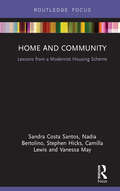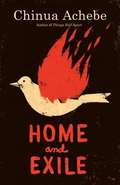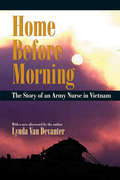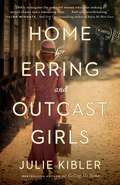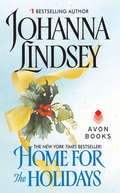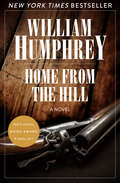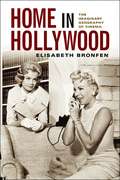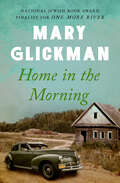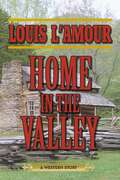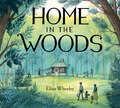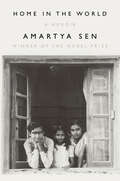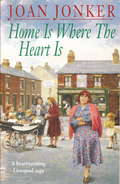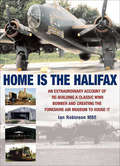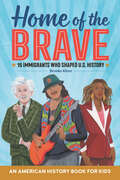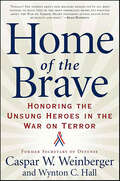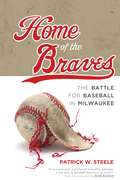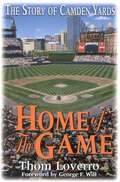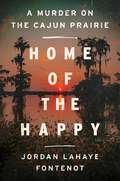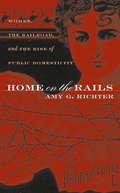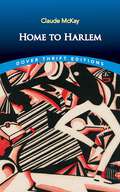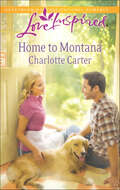- Table View
- List View
Home and Community: Lessons from a Modernist Housing Scheme
by Vanessa May Stephen Hicks Camilla Lewis Sandra Costa Santos Nadia BertolinoExamining the relationships between architecture, home and community in the Claremont Court housing scheme in Edinburgh, Home and Community provides a novel perspective on the enabling potential of architecture that encompasses physical, spatial, relational and temporal phenomena. Based on the AHRC funded project "Place and Belonging", the chapters draw on innovative spatial layouts amid Scottish policymakers' concerns of social change in the 1960s, to develop theoretical understandings between architecture, home, and community. By approaching the discourse on home, and by positioning the home at the confluence of a network of sociocultural identities bound by spatial awareness and design, the writers draw on sociological interpretations of cultural negotiation as well as theoretical underpinnings in architectural design. In so doing, they suggest a reinterpretation of the facilitating role of architecture as sensitive to physical and socio-cultural reconstruction. Drawn from interviews with residents, architectural surveys, contextual mapping and other visual methods, Home and Community explores home as a construct that is enmeshed with the architectural affordances that the housing scheme represents, that is useful to both architecture and sociology students, as well as practitioners and urban planners.
Home and Exile
by Chinua AchebeMore personally revealing than anything Achebe has written, "Home and Exile"--the great Nigerian novelist's first book in more than ten years--is a major statement on the importance of stories as real sources of power, especially for those whose stories have traditionally been told by outsiders. In three elegant essays, Achebe seeks to rescue African culture from narratives written about it by Europeans. Looking through the prism of his experiences as a student in English schools in Nigeria, he provides devastating examples of European cultural imperialism. He examines the impact that his novel "Things Fall Apart" had on efforts to reclaim Africa's story. And he argues for the importance of writing and living the African experience because, he believes, Africa needs stories told by Africans.
Home and Homeland in Asian Diaspora: Transnational Reflections in Art, Literature, and Film
by Kyunghee Pyun Jean AmatoWhile many of us may strive to locate a sense of identity and belonging expressed via a home or ancestral homeland; today, however, this connection is no longer, if it ever was, a straightforward identification. This collection aims at mapping narratives or artwork of home/homeland that present shared, private, multifaceted, and often contested experiences of place, especially in the context of today’s migrations and upheavals, along with alarming degrees of increased nativism, racism, and anti-Asian violence. This volume includes papers by artists, filmmakers, and comparative scholars from diverse disciplines of literature, cinema, art history, cultural studies, and gender studies. Our goal is to help literary and art historian scholars in Asian diaspora studies, better decolonize and open up traditional research methodologies, curricula, and pedagogies.
Home before Morning: The Story of an Army Nurse in Vietnam
by Lynda van Van DevanterLynda Van Devanter was the girl next door, the cheerleader who went to Catholic schools, enjoyed sports, and got along well with her four sisters and parents. After high school she attended nursing school and then did something that would shatter her secure world for the rest of her life: in 1969, she joined the army and was shipped to Vietnam. When she arrived in Vietnam her idealistic view of the war vanished quickly. She worked long and arduous hours in cramped, ill-equipped, understaffed operating rooms. She saw friends die. Witnessing a war close-up, operating on soldiers and civilians whose injuries were catastrophic, she found the very foundations of her thinking changing daily. After one traumatic year, she came home, a Vietnam veteran. Coming home was nearly as devastating as the time she spent in Asia. Nothing was the same -- including Lynda herself. Viewed by many as a murderer instead of a healer, she felt isolated and angry. The anger turned to depression; like many other Vietnam veterans she suffered from delayed stress syndrome. Working in hospitals brought back chilling scenes of hopelessly wounded soldiers. A marriage ended in divorce. The war that was fought physically halfway around the world had become a personal, internal battle.Home before Morning is the story of a woman whose courage, stamina, and personal history make this a compelling autobiography. It is also the saga of others who went to war to aid the wounded and came back wounded -- physically and emotionally -- themselves. And, it is the true story of one person's triumphs: her understanding of, and coming to terms with, her destiny.
Home by Morning
by Kaki WarnerThe award-winning author of Where the Horses Run makes her eagerly anticipated return to Heartbreak Creek for the final book in a trilogy of soul-stirring historical romance.<P><P> Thomas Redstone--a former Cheyenne warrior seeking new purpose by following the ways of his white grandfather--is returning to Heartbreak Creek, Colorado, when he decides to give the woman he loves one last chance to accept him into her life.<P> Prudence Lincoln's beauty and education have brought her little joy. Envied by blacks for the advantages she's had, and reviled by whites for her mixed blood, she's proving herself by helping ex-slaves prepare for newfound freedom. Thomas has no place in her future, no matter how much she loves him.<P>He's suffered only hardship. She was raised in privilege. Their only common ground is the spark between them that won't die. Yet even as evil forces tear them apart again, they discover that courage can be a weapon, happiness is a choice, and love can triumph over anything.From the Paperback edition.
Home for Erring and Outcast Girls: A Novel
by Julie KiblerAn emotionally raw and resonant story of love, loss, and the enduring power of friendship, following the lives of two young women connected by a home for “fallen girls,” and inspired by historical events. “Home for Erring and Outcast Girls deftly reimagines the wounded women who came seeking a second chance and a sustaining hope.”—Lisa Wingate, author of Before We Were Yours In turn-of-the-20th century Texas, the Berachah Home for the Redemption and Protection of Erring Girls is an unprecedented beacon of hope for young women consigned to the dangerous poverty of the streets by birth, circumstance, or personal tragedy. Built in 1903 on the dusty outskirts of Arlington, a remote dot between Dallas and Fort Worth’s red-light districts, the progressive home bucks public opinion by offering faith, training, and rehabilitation to prostitutes, addicts, unwed mothers, and “ruined” girls without forcibly separating mothers from children. When Lizzie Bates and Mattie McBride meet there—one sick and abused, but desperately clinging to her young daughter, the other jilted by the beau who fathered her ailing son—they form a friendship that will see them through unbearable loss, heartbreak, difficult choices, and ultimately, diverging paths. A century later, Cate Sutton, a reclusive university librarian, uncovers the hidden histories of the two troubled women as she stumbles upon the cemetery on the home’s former grounds and begins to comb through its archives in her library. Pulled by an indescribable connection, what Cate discovers about their stories leads her to confront her own heartbreaking past, and to reclaim the life she thought she'd let go forever. With great pathos and powerful emotional resonance, Home for Erring and Outcast Girls explores the dark roads that lead us to ruin, and the paths we take to return to ourselves.
Home for the Holidays
by Johanna LindseyLeft to handle the rumors other family's bankruptcy and impending eviction, Larissa Ascots wishes for a merry Christmas seem to be in peril for the first time in her sheltered life. A charming would-be "benefactor,"Vincent Everett, the Baron of Windsmoor, has offered to shelter Larissa and her young brother. But more than Yuletide spirit seems to have inspired the baron's generostity.From the moment he first set eyes on Larissa, the highborn rogue was bewitched. And now that she has taken up residence in his home, he aches with wanting her-a most unfortunate state of affairs, since the proud beauty obviously despises him ... and since Vincent has sworn to seek a righteous vengeance on the Ascot family.
Home from the Hill: A Novel (Voices Of The South Ser.)
by William HumphreyNational Book Award Finalist: The mesmerizing saga of a Texas family torn apart by passion and pride. Twelve years after Hannah Hunnicutt was committed to a Dallas asylum, her body is brought home to northeast Texas to be buried alongside those of her husband and son. Etched on all three gravestones is the same date of death: May 28, 1939. Home from the Hill is the story of that tragic day and the dramatic events leading up to it. The biggest landowner in the county, Captain Wade Hunnicutt was a charismatic war hero whose legendary hunting skills extended to the wives of his friends and neighbors. Humiliated by her husband&’s philandering, Hannah grew to despise Captain Wade but was too proud to ask for a divorce; instead, she devoted herself to her only child. Torn between his mother&’s adoration and an overwhelming need to win his father&’s approval, Theron tried to become his own man. And he might have succeeded if he hadn&’t fallen in love with the beautiful and innocent Libby Halstead. William Humphrey&’s dazzling debut novel, the inspiration for a major motion picture starring Robert Mitchum, is a masterpiece of twentieth-century American literature, as intense and thrilling as the Hunnicutts themselves.This ebook features an illustrated biography of William Humphrey including rare photos form the author&’s estate.
Home in Hollywood: The Imaginary Geography of Cinema
by Elisabeth BronfenWho can forget Dorothy's quest for the great and powerful Oz as she tried to return to her beloved Kansas? She thought she needed a wizard's magic, only to discover that home—and the power to get there—had been with her all along. This engaging and provocative book proposes that Hollywood has created an imaginary cinematic geography filled with people and places we recognize and to which we are irresistibly drawn. Each viewing of a film stirs, in a very real and charismatic way, feelings of home, and the comfort of returning to films like familiar haunts is at the core of our nostalgic desire. Leading us on a journey through American film, Elisabeth Bronfen examines the different ways home is constructed in the development of cinematic narrative. Each chapter includes a close reading of such classic films as Fleming's The Wizard of Oz, Sirk's Imitation of Life, Burton's Batman Returns, Hitchcock's Rebecca, Ford's The Searchers, and Sayles's Lone Star.
Home in the Morning
by Mary GlickmanA Southern family confronts the tumult of the 1960s, and the secrets that bind its members together, in a novel by a National Jewish Book Award finalist. Jackson Sassaport is a man who often finds himself in the middle. Whether torn between Stella, his beloved and opinionated Yankee wife, and Katherine Marie, the African American girl who first stole his teenage heart; or between standing up for his beliefs and acquiescing to his prominent Jewish family&’s imperative to not stand out in the segregated South, Jackson learns to balance the secrets and deceptions of those around him. But one fateful night in 1960 will make the man in the middle reconsider his obligations to propriety and family, and will start a chain of events that will change his life and the lives of those around him forever. Home in the Morning follows Jackson&’s journey from his childhood as a coddled son of the Old South to his struggle as a young man eager to find his place in the civil rights movement while protecting his family. Flashing back between Jackson's adult life as a successful lawyer and his youth, Mary Glickman&’s riveting novel traces the ways that race and prejudice, family and love intertwine to shape our lives. This ebook features rare photos and never-before-seen documents from the author&’s personal collection.
Home in the Morning
by Mary GlickmanA Southern family confronts the tumult of the 1960s, and the secrets that bind its members together, in a novel by a National Jewish Book Award finalist. Jackson Sassaport is a man who often finds himself in the middle. Whether torn between Stella, his beloved and opinionated Yankee wife, and Katherine Marie, the African American girl who first stole his teenage heart; or between standing up for his beliefs and acquiescing to his prominent Jewish family&’s imperative to not stand out in the segregated South, Jackson learns to balance the secrets and deceptions of those around him. But one fateful night in 1960 will make the man in the middle reconsider his obligations to propriety and family, and will start a chain of events that will change his life and the lives of those around him forever. Home in the Morning follows Jackson&’s journey from his childhood as a coddled son of the Old South to his struggle as a young man eager to find his place in the civil rights movement while protecting his family. Flashing back between Jackson's adult life as a successful lawyer and his youth, Mary Glickman&’s riveting novel traces the ways that race and prejudice, family and love intertwine to shape our lives. This ebook features rare photos and never-before-seen documents from the author&’s personal collection.
Home in the Valley: A Western Sextet
by Louis L'AmourA collection of some of the best short fiction writing from the most famous Western author of all time.Louis L'Amour is indisputably the most famous and well-respected writer to ever work in the Western genre. His stories captured life on the frontier at its most captivating and exciting, and with well over two hundred million copies sold of his work, his characters and stories have left an indelible mark on popular culture.Home in the Valley collects six of L'Amour's short stories, written early in his career. In the title story, Steve Mehan had accomplished what man had believed to be impossible. He had taken cattle from the home range in Nevada to sell in California in the dead of winter. Now the money from the cattle is on deposit with Dake & Company, but while in Sacramento, California, he learns to his shock that the company has failed and his money is almost surely lost. There is one hope: that news of the closure hasn't yet reached a branch in faraway Portland, Oregon. The only chance to get the money back will be to beat the steamer boat carrying the news to Portland. To do that, Steve will need a long relay of horses, and he will have to be almost continuously in the saddle.L'Amour's best work conjures up a romantic, strangely compelling vision of the American West. Find out for yourself why L'Amour continues to be a household name and, even decades after his death, the gold standard for authentic Western storytelling.
Home in the Woods
by Eliza WheelerThis stunningly beautiful picture book from New York Times bestselling author-illustrator Eliza Wheeler is based on her grandmother's childhood and pays homage to a family's fortitude as they discover the meaning of home.Eliza Wheeler's gorgeously illustrated book tells the story of what happens when six-year-old Marvel, her seven siblings, and their mom must start all over again after their father has died. Deep in the woods of Wisconsin they find a tar-paper shack. It doesn't seem like much of a home, but they soon start seeing what it could be. During their first year it's a struggle to maintain the shack and make sure they have enough to eat. But each season also brings its own delights and blessings--and the children always find a way to have fun. Most importantly, the family finds immense joy in being together, surrounded by nature. And slowly, their little shack starts feeling like a true home--warm, bright, and filled up with love.
Home in the World: A Memoir
by Amartya SenFrom Nobel Prize winner Amartya Sen, a long-awaited memoir about home, belonging, inequality, and identity, recounting a singular life devoted to betterment of humanity. The Nobel laureate Amartya Sen is one of a handful of people who may truly be called “a global intellectual” (Financial Times). A towering figure in the field of economics, Sen is perhaps best known for his work on poverty and famine, as inspired by events in his boyhood home of West Bengal, India. But Sen has, in fact, called many places “home,” including Dhaka, in modern Bangladesh; Kolkata, where he first studied economics; and Trinity College, Cambridge, where he engaged with the greatest minds of his generation. In Home in the World, these “homes” collectively form an unparalleled and profoundly truthful vision of twentieth- and twenty-first-century life. Here Sen, “one of the most distinguished minds of our time” (New York Review of Books), interweaves scenes from his remarkable life with candid philosophical reflections on economics, welfare, and social justice, demonstrating how his experiences—in Asia, Europe, and later America—vitally informed his work. In exquisite prose, Sen evokes his childhood travels on the rivers of Bengal, as well as the “quiet beauty” of Dhaka. The Mandalay of Orwell and Kipling is recast as a flourishing cultural center with pagodas, palaces, and bazaars, “always humming with intriguing activities.” With characteristic moral clarity and compassion, Sen reflects on the cataclysmic events that soon tore his world asunder, from the Bengal famine of 1943 to the struggle for Indian independence against colonial tyranny—and the outbreak of political violence that accompanied the end of British rule. Witnessing these lacerating tragedies only amplified Sen’s sense of social purpose. He went on to study famine and inequality, wholly reconstructing theories of social choice and development. In 1998, he was awarded the Nobel Prize for his contributions to welfare economics, which included a fuller understanding of poverty as the deprivation of human capability. Still Sen, a tireless champion of the dispossessed, remains an activist, working now as ever to empower vulnerable minorities and break down walls among warring ethnic groups. As much a book of penetrating ideas as of people and places, Home in the World is the ultimate “portrait of a citizen of the world” (Spectator), telling an extraordinary story of human empathy across distance and time, and above all, of being at home in the world.
Home is Where the Heart Is: A touching saga of love, family and hope (Eileen Gillmoss series, Book 3)
by Joan JonkerWhen tragedy strikes, a young mother's friends and family ensure she is never alone... Joan Jonker's saga, Home is Where the Heart Is, brings to life a close-knit Liverpudlian community, in the final instalment of the Eileen Gillmoss series. Perfect for fans of Katie Flynn and Dilly Court.'Warm, witty... loved by her legions of fans' - Liverpool EchoWhen fun-loving, eighteen-stone Eileen Gillmoss announces that she's expecting a baby, her husband Bill thinks it's another one of her jokes. After all, it's twelve years since Edna, their youngest, was born. But when it sinks in that a baby really is on the way, Bill is over the moon and decides that the family should move out of their two-up, two-down house in Liverpool to one with more spacious accommodation. Eileen digs her heels in at first, reluctant to leave the house she loves and friends and neighbours so dear. But a scare early in Eileen's pregnancy strengthens Bill's resolve to provide a more comfortable home for his wife. Before Eileen knows what's hit her, she's installed in a smart home with posh new neighbours. Then tragedy strikes and Eileen must come to terms with a loss far greater than leaving behind her beloved neighbourhood. She tries to put on a brave face, but she can't fool the people who love her, who miss the smile on that round, chubby face and the laughter ringing through her house. They vow to make amends and fate steps in to lend a helping hand... What readers are saying about Home is Where the Heart Is: 'From the first page you are drawn into this wonderful woman's life and family as if you belong there. Joan Jonker creates a web of family crises and tragedies mixed with the never flagging spirit of Eileen Gilmoss to keep you hungry for more' 'As always with Joan it's a mix of hard, nitty, gritty life and fun thrown into the mix, never a dull moment with her books, tears of woe one minute and laughter the next'
Home is the Halifax: An Extraordinary Account of Re-Building a Classic WWII Bomber and Creating the Yorkshire Air Museum to House It
by Ian RobinsonA World War II veteran details wartime life in Yorkshire and his postwar efforts to build a museum and restore a Halifax bomber. Between 1935 and 1945, Yorkshire became home to 41 military airfields, the majority located in the Vale of York. The area was often referred to as a land-based aircraft carrier. At 16, Ian Robinson began working for the Handley Page aircraft manufacturer at their repair depot at Clifton, York. There, Halifax bombers used by 4 Group RAF and 6 Group Royal Canadian Air Force were repaired and test flown. During the Second World War, about 30 squadrons operated from these Yorkshire airfields, and the Book of Remembrance in York Minster records more than 18,000 names of those killed flying from these Yorkshire bases. Postwar, Ian felt aggrieved that little was left commemorating these sacrifices and that little was left of the Halifax bomber. Then in 1983, a small group of aviation enthusiasts got together to create a commemorative museum at Elvington, and Ian joined them. He became a pivotal player in forming the Yorkshire Air Museum and Allied Air Forces Memorial. Yet Ian felt the museum was incomplete without a Halifax. So, starting with a derelict fuselage which was being used as a hen-coop on the Isle of Lewis, he set about gathering all the hundreds of bits needed to reassemble the aircraft. This is Ian&’s account of those 13 extraordinary years before the Friday the 13th was rolled out on Friday, September 13, 1996.
Home of the Brave: 15 Immigrants Who Shaped U.S. History (Biographies for Kids)
by Brooke KhanDiscover the stories of extraordinary immigrants who changed America—a history book for kids ages 9 to 12 The United States has always been a nation of immigrants—and now you can learn all about the amazing people who've helped shape it, with this history book for kids age 9-12. Home of the Brave: An American History Book for Kids gives you an exciting and engaging look into the lives and contributions of these incredible individuals. From Levi Strauss to Isabel Allende, discover how these dedicated and creative people made their mark—and how you can follow in their footsteps—with this fun history book for kids age 9-12. An American history book for kids age 9-12 should include: 15 inspiring stories—Learn from the experiences of famous American immigrants, including labor activist Mary Harris Jones, architect I. M. Pei, and guitarist Carlos Santana. Multi-page biographies—This history book for kids age 9-12 goes beyond the obvious so you can find all kinds of remarkable facts about the lives of these exceptional Americans. Beyond the book—Want to learn more? Each biography includes suggestions for places to read more, plus super fun (and educational!) activities. Find a role model—or 15 of them!—in this beautifully illustrated history book for kids age 9-12.
Home of the Brave: Honoring the Unsung Heroes in the War on Terror
by Caspar W. Weinberger Wynton C. HallIn Home of the Brave, former Secretary of Defense Caspar W. Weinberger brings us a chronicle of heroism in the War on Terror.They are nineteen of the most highly decorated soldiers, sailors, airmen, and marines in the United States military, and yet most Americans don't even know their names. In this riveting, intimate account, former Secretary of Defense Caspar Weinberger and Wynton C. Hall tell stories of jaw-dropping heroism and hope in Afghanistan and Iraq. Home of the Brave takes readers beyond the bullets and battles and into the hearts and minds of the men and women who are fighting terrorists overseas so that America doesn't have to fight them at home. These are the powerful, true-life stories of the hopes, fears, and triumphs these men and women experienced fighting the War on Terror. But more than that, these are the stories of soldiers who risked everything to save lives and defend freedom. Including:*Lieutenant Colonel Mark Mitchell, the Green Beret leader whose 15-man Special Forces team took 500 Al Qaeda and Taliban prisoners, and posthumously repatriated the body of the first American to die in combat in the War on Terror, CIA agent Johnny "Mike" Spann.*Army National Guard Sergeant Leigh Ann Hester, the first woman ever to be awarded the Silver Star for combat, whose sharp-shooting and bravery played an enormous role in fighting off over fifty Iraqi insurgents while her ten-person squad protected a convoy of supplies on the way to fellow soldiers. *Sergeant Rafael Peralta, a Mexican immigrant, enlisted in the Marines the same day he received his green card. Wounded from enemy fire, Peralta used his body to smother the blast of an enemy grenade and gave his life so that his marine brothers could live. These real-life heroes remind us of American history's most enduring lesson: Ours would not be the land of the free if it were not also the home of the brave.At the Publisher's request, this title is being sold without Digital Rights Management Software (DRM) applied.
Home of the Braves: The Battle for Baseball in Milwaukee
by Patrick SteeleWhen the struggling Boston Braves relocated to Milwaukee in March 1953, the city went wild for its new baseball team. Soon, the Braves were winning games, drawing bigger crowds than any team but the Brooklyn Dodgers, and turning Hank Aaron, Eddie Mathews, and Warren Spahn into Hall of Famers. Within five years the team would win a World Series and two pennants. It seemed the dawn of a new dynasty. Impassioned fans wore their hearts on their sleeves. Yet in October 1964 team owners made a shocking announcement: the Braves were moving to Atlanta. In the decades since, many have tried to understand why the Braves left Milwaukee. Fans blamed greedy owners and the lure of Coca Cola cash. Team management claimed they weren't getting enough local support. Patrick Steele delves deeply into all facets of the story, looking at the changing business of baseball in the 1960s, the interactions of the team owners with the government officials who controlled County Stadium, the surging success of the Green Bay Packers, and much more, to understand how the "Milwaukee Miracle" went south.
Home of the Game: The Story of Camden Yards
by Thom LoverroHome of the Game celebrates the unique position Camden Yards holds as a symbol of the modern game and a prototype for new ballparks across the country. It reveals how this revolutionary ballpark has changed the face of baseball as a sport and a business.
Home of the Happy: A Murder on the Cajun Prairie
by Jordan LaHaye Fontenot"Riveting and atmospheric, Home of the Happy is also a heartfelt grappling with a trauma in the author’s family and her attempts to unravel its secrets once and for all. LaHaye Fontenot’s writing is urgent, fueled not just by a desire for justice but by love for her ancestors and the Cajun community of south Louisiana. A must-read for true crime and mystery fans."— Ana Reyes, New York Times bestselling author of The House in the PinesOn January 16, 1983, Aubrey LaHaye’s body was found floating in the Bayou Nezpique. His kidnapping ten days before sparked “the biggest manhunt in the history of Evangeline Parish.” But his descendants would hear the story as lore, in whispers of the dreadful day the FBI landed a helicopter in the family’s front lawn and set out on horseback to search for the seventy-year-old banker.Decades later, Aubrey’s great-granddaughter Jordan LaHaye Fontenot asked her father, the parish urologist, to tell the full story. He revealed that to this day, every few months, one of his patients will bring up his grandfather’s murder, and the man accused of killing him, John Brady Balfa, who remains at the Louisiana State Penitentiary at Angola serving a life sentence. They’ll say, in so many words: “Dr. Marcel, I really don’t think that Balfa boy killed your granddaddy.” For readers of Maggie Nelson’s The Red Parts and Emma Copley Eisenberg's The Third Rainbow Girl, Home of the Happy unravels the layers of suffering borne of this brutal crime—and investigates the mysteries that linger beneath generations of silence. Is it possible that an innocent man languishes in prison, still, wrongly convicted of murdering the author’s great-grandfather?
Home on the Rails
by Amy G. RichterRecognizing the railroad's importance as both symbol and experience in Victorian America, Amy G. Richter follows women travelers onto trains and considers the consequences of their presence there.For a time, Richter argues, nineteenth-century Americans imagined the public realm as a chaotic and dangerous place full of potential, where various groups came together, collided, and influenced one another, for better or worse. The example of the American railroad reveals how, by the beginning of the twentieth century, this image was replaced by one of a domesticated public realm--a public space in which both women and men increasingly strove to make themselves "at home."Through efforts that ranged from the homey touches of railroad car decor to advertising images celebrating female travelers and legal cases sanctioning gender-segregated spaces, travelers and railroad companies transformed the railroad from a place of risk and almost unlimited social mixing into one in which white men and women alleviated the stress of unpleasant social contact. Making themselves "at home" aboard the trains, white men and women domesticated the railroad for themselves and paved the way for a racially segregated and class-stratified public space that freed women from the home yet still preserved the railroad as a masculine domain.
Home to Harlem (Dover Thrift Editions: Black History)
by Claude McKayClaude McKay’s 1928 novel, Home to Harlem, is one of the most important works of the Harlem Renaissance. With raw, unflinching candor, McKay explores race, identity, love, and loss and gives voice to the plight of young Black men during the Jazz Age. Jake Brown, a Black American soldier and a World War I deserter, returns to Harlem and struggles to find his place in a vibrant working-class community that’s rife with poverty, crime, and racism. He meets various characters, including a displaced Haitian intellectual, prostitutes, hustlers, and jazz musicians, and he experiences everything from love and joy to despair and violence.
Home to Montana
by Charlotte CarterWhere The Heart LeadsStaying in one place was never Nick Carbini's plan. When his troubled past leads him to Bear Lake, Montana, single mom Alisa Machak makes him consider putting down roots. Alisa doesn't have a problem letting Nick work in her diner, but when he starts edging his way into her heart, she has to draw the line. He reminds her too much of her son's father, another drifter who abandoned them both. Nick wishes he could be there for them, but believes he's not fit to be a husband. When his worst fears come true one night, it's up to Alisa to show him the perfect recipe for a forever romance.
Home to the Prairie (The Days of Laura Ingalls Wilder, Book #4)
by T. L. TedrowWhen Pa comes to visit the farm in Missouri, he and Laura have so much fun reminiscing about the old days that they decide to set out in search of their old homestead, and on the way they relive many of the special memories of their past.
